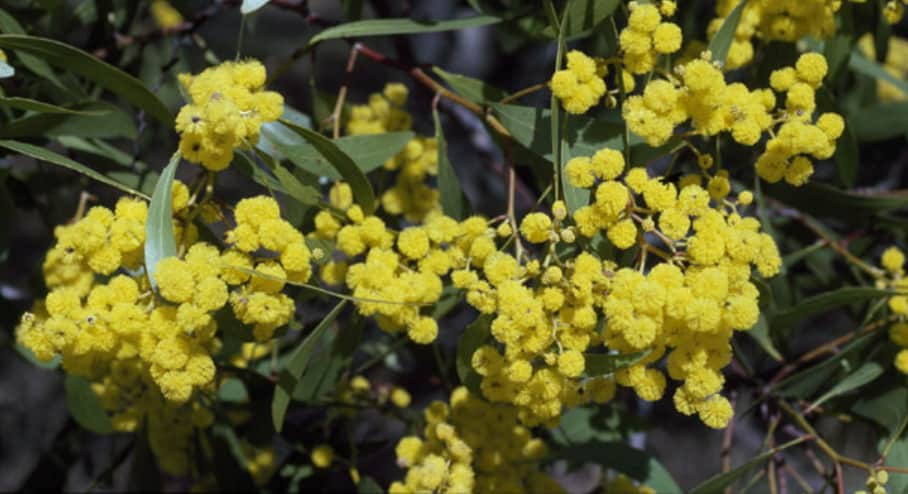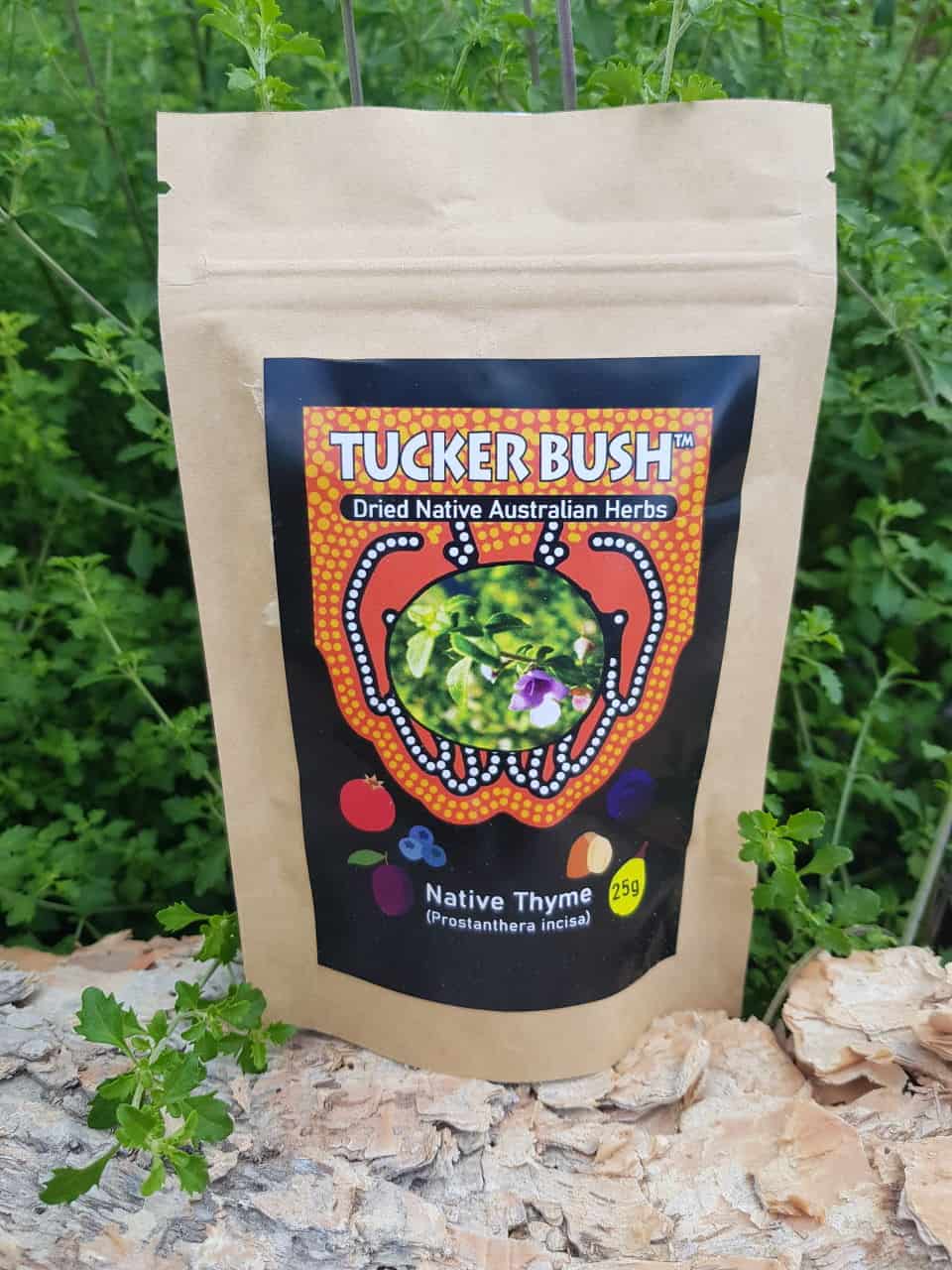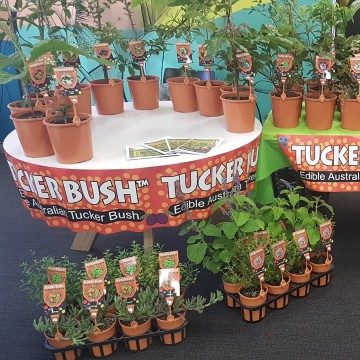Meet the wattleseed, a versatile Australian bushfood with a long history and an exciting future. Wattleseed comes from the Acacia tree, of which there are about 985 different species in Australia. You can recognise them by their fuzzy golden flowers during the warmer months, as well as the seed pods that follow.
In fact, the wattle is so recognisably Australian that it’s served as the national floral emblem since 1912, though only formally adopted at the federal Bicentennial in 1988. Of course, Aboriginal peoples knew about wattles and wattleseed long before then.
Traditionally used in Aboriginal cuisine, wattleseed was typically ground into flour for damper. These days you can find it in a range of sweet and savoury foods like ice-cream, muffins, roast meats, teas, and even as a substitute for coffee.

The Golden Wattle (Acacia pycnantha) was informally regarded as Australia’s national floral emblem until its official adoption in 1988. It is often planted as an ornamental tree or as a windbreak.
Our next big superfood?
Be careful when you hear the term “superfood”, as the word is often used without scientific evidence to support hyped-up health claims. However, here’s what we know so far about the wattleseed’s nutritional profile. Note that not all wattleseeds are created equal — some species contain higher concentrations than others when it comes to particular nutrients.
Low glycemic index (GI)
Wattleseed is generally known as a low GI food, meaning its carbohydrates break down slowly in the body, resulting in sustained energy levels rather than an intense blood sugar spike. This is good news for people with diabetes as well as those looking to lose or manage weight. Other examples of low GI foods are whole grains, legumes and starchy vegetables.
High in micronutrients
Wattleseed also contains high concentrations of dietary micronutrients such as iron, calcium, potassium and zinc, though actual concentrations vary between species. For example, the Manna Wattle (Acacia microbotrya) contains 5.2mg or iron per 100g of seed, while the Elegant Wattle (Acacia victoriae) offers only half as much.
Contains anti-nutrients that are easily removed
Raw wattleseed contains anti-nutrients that are easily removed by soaking, boiling and roasting. Anti-nutrients, such as protease inhibitors, saponins and oxalates, interfere with the body’s ability to absorb and process nutrients, and are present in many raw seeds and legumes. (Note: All Tucker Bush dried herbs are safely processed to remove anti-nutrients prior to packaging.)
Rich source of protein
Wattleseed is a protein-rich plant, with seeds typically comprising 18–35% protein depending on species. Recent research into specific Acacias found seeds from the Red-eyed Wattle (Acacia cyclops) containing 27.1% protein, which is more than you’ll find in lentils (24.6%) and chickpeas (20.5%) (Chong et al., 2019).
Naturally caffeine-free
Wattleseed does not contain caffeine, yet boasts a nutty and sometimes spicy aroma similar to coffee. After roasting, wattleseed can be ground and steeped in hot water for a naturally caffeine-free beverage with hints of biscuit flavour.

A wattleseed sugar infusion can be used to make an espresso martini cocktail with hints of nutty bushfood flavour. Just make sure the seeds have been properly processed before adding them to food and drink.
Bushfood and bush medicine
Wattleseeds aren’t just for damper and coffee; they’re great in other foods too. Try adding ground wattleseed and River Mint to your next batch of brownies. Pop a generous tablespoon into your profiterole batter, then finish off with dark chocolate and finger lime. Or if you’re settling in for a “quiet drink”, try whipping up a wattleseed espresso martini.
Beyond the seeds, the gum of some wattle species are also edible. Noongar Aboriginal people from Western Australia would mix the gum from Raspberry Jam Wattle (Acacia acuminata) with water to make a drink called djilyan (Hansen & Horsfall, 2019), and use Red-eyed Wattle for chewing gum as well as homemade glue (City of Joondalup, 2020).
The gum, flowers, leaves and bark from various species of wattle were also used as bush medicine to treat diarrhoea, blisters and burns, coughs, eczema, and general sickness.
Where to get wattleseed
Buy it — safest and easiest
Found in supermarkets and specialty stores, packaged ground wattleseed tends to come pre-roasted. This means it’s ready for consumption straight out of the packet.
Grow it — the most satisfying
There’s nothing quite like growing and eating your own bushfood. The wattleseed plants in our range are hardy species that tolerate most soils and growing conditions.
References:
- Hansen, V., & Horsfall, J. (2019). Noongar Bush Tucker: Bush Food Plants and Fungi of the South-West of Western Australia. UWA Publishing.
- Acacia pycnantha. (2023, May 7). In Wikipedia. https://en.wikipedia.org/w/index.php?title=Acacia_pycnantha&oldid=1153534014#Symbolic_and_cultural_references
- List of Australian floral emblems. (2023, June 23). In Wikipedia. https://en.wikipedia.org/w/index.php?title=List_of_Australian_floral_emblems&oldid=1094542590
- Superfood. (2023, July 8). In Wikipedia. https://en.wikipedia.org/w/index.php?title=Superfood&oldid=1164142964
- Chong, W. S. C., Dykes, G. A., & Coorey, R. (2019). Chemical Composition and Anti-Nutritional Profiling of Wattle (Acacia cyclops, Acacia microbotrya, and Acacia victoriae) Seed Originating from Western Australia. Plant Foods for Human Nutrition, 74(4). https://doi.org/10.1007/s11130-019-00772-4
- City of Joondalup. (2020). Plants and People in Mooro Country: Noongar Plant Use in Yellagonga Regional Park (Fourth Edition 2020), Perth, WA.
- Hansen, V., & Horsfall, J. (2021). Noongar Bush Medicine: Medicinal Plants of the South-West of Western Australia. UWA Publishing. (Original work published in 2016)
- (2015, January 30). Wattleseed. The Australian Superfood Co. Retrieved July 19, 2023, from https://austsuperfoods.com.au/wattleseed/
- (2022, June). Glycaemic index (GI). Healthdirect. Retrieved July 19, 2023, from https://www.healthdirect.gov.au/glycaemic-index-gi




